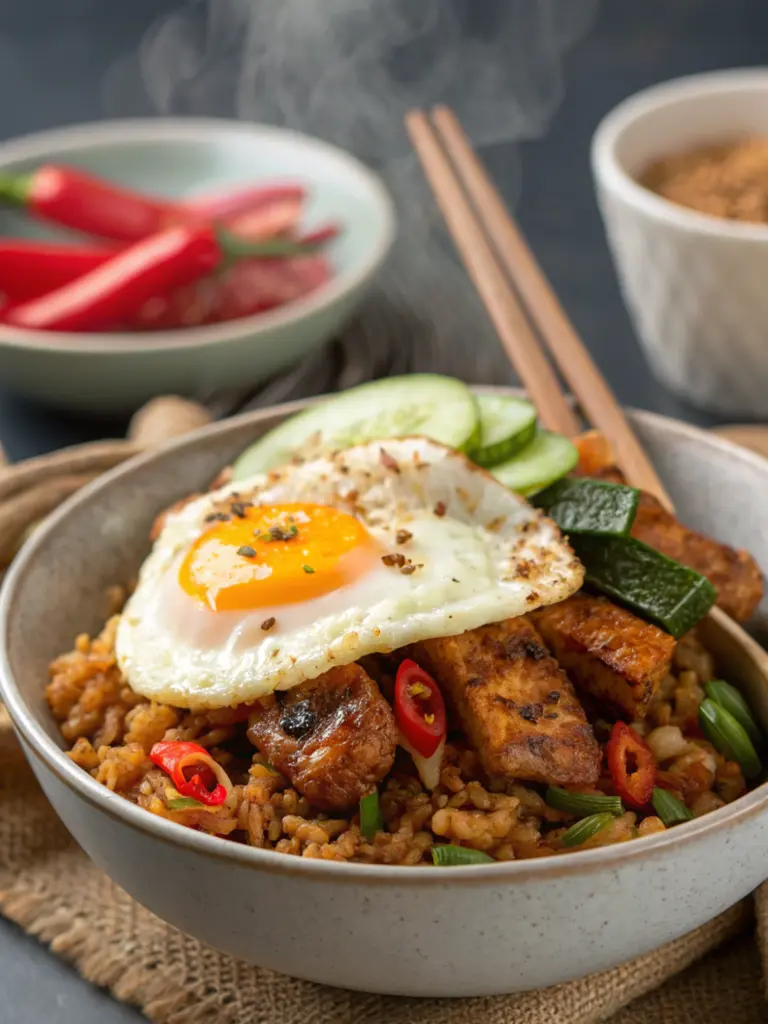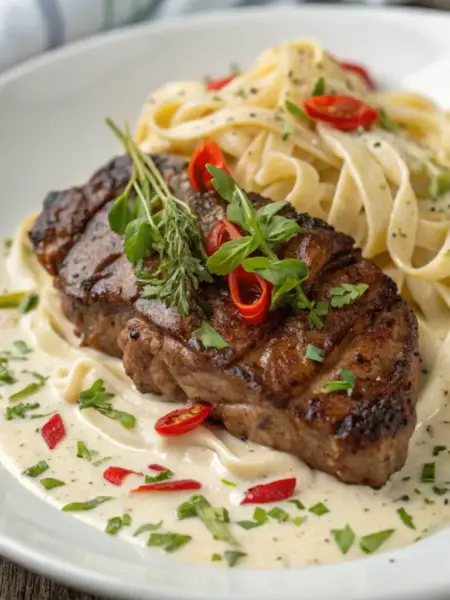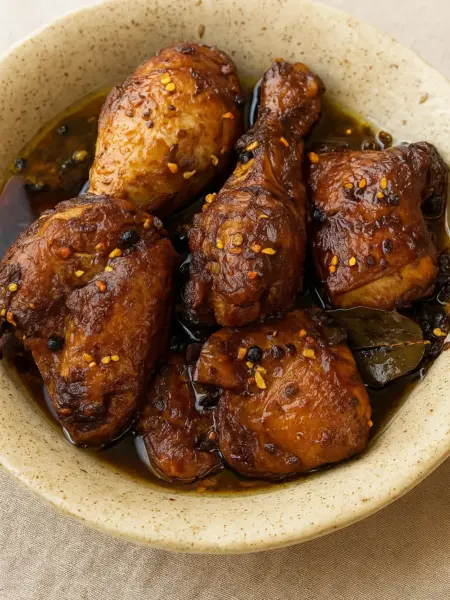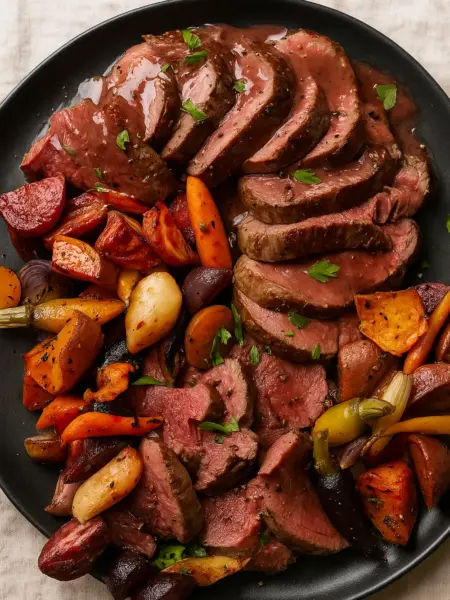This post may contain affiliate links, meaning I may earn a commission if you make a purchase, at no extra cost to you. I only recommend products I trust. Thank you for your support.
Nasi goreng means “fried rice” in Indonesian. This spicy Indonesian style fried rice is distinguished by the use of kecap manis (sweet soy sauce), garlic, shallots, and often shrimp paste or sambal oelek chili paste.
Traditionally, nasi goreng was a way to use yesterday’s rice, now it’s celebrated as Indonesia’s national fried rice. Locals often call it the ultimate comfort food, perfect for any meal of the day.
This garlicky, kecap manis–colored rice is stir-fried in a hot wok until each grain is fragrant with chili, shallots, and soy, then topped with a golden fried egg and crunchy acar.
Authentic nasi goreng is often served with a sunny-side-up egg and atjar or acar (mixed pickles) on the side; this nasi goreng recipe brings those elements together in one bold meal.
Acar is an Indonesian (and broader Southeast Asian) pickled vegetable condiment. It’s typically made with a mix of vegetables like cucumber, carrots, shallots, and sometimes chilies, all pickled in a sweet-sour brine of vinegar, sugar, and salt.
I was hooked the first time I tasted nasi goreng on a street corner in Jakarta. The combination of sweet kecap-coated rice with a hint of chili heat and crispy toppings was unlike any fried rice I’d tried before.
Because every Indonesian family makes nasi goreng slightly differently, I encourage creativity. Using leftovers, shrimp, chicken, or more veggies like peas or green beans work well.
✅ Read the entire article to ensure you’re fully prepared with all the necessary equipment and ingredients. The full recipe and cooking instructions are below.
Key Ingredients for Indonesian Nasi Goreng Recipe
Here’s a look at the essential components of a spicy Indonesian nasi goreng recipe:
1. Cooked Rice (preferably day-old)
- Cold, slightly dried-out rice fries better and won’t clump. Fresh rice tends to be too soft and sticky for authentic nasi goreng texture.
- Jasmine rice is most commonly used, but any medium- to long-grain rice works.
2. Sambal Oelek or Homemade Sambal
- This chili paste brings the heat. Sambal is a blend of red chilies, garlic, vinegar, and salt. Adjust to your spice level.
- You can also use a milder sambal bajak or a store-bought chili garlic sauce.
3. Kecap Manis
- It gives nasi goreng its signature sweet-salty flavor and deep mahogany color. If you can’t find kecap manis, mix regular soy sauce with a bit of brown sugar or molasses.
4. Shallots, Garlic, and Scallions
- These aromatics build the dish’s foundational flavor. Mince finely and sauté until golden for a fragrant base.
5. Tempeh
- A plant-based protein powerhouse, tempeh soaks up the flavors of the dish and adds a satisfying, meaty bite. Fry or sauté it before mixing it into the rice to get a crispy texture.
6. Eggs
- A fried egg with a runny yolk on top adds richness and balances the spice. Fry until the edges are crispy for the perfect contrast.
7. Pickled Vegetables (Acar)
- The sour crunch from quick-pickled cucumbers, carrots, and shallots cuts through the richness of the fried rice. Make them ahead of time and chill for maximum flavor.
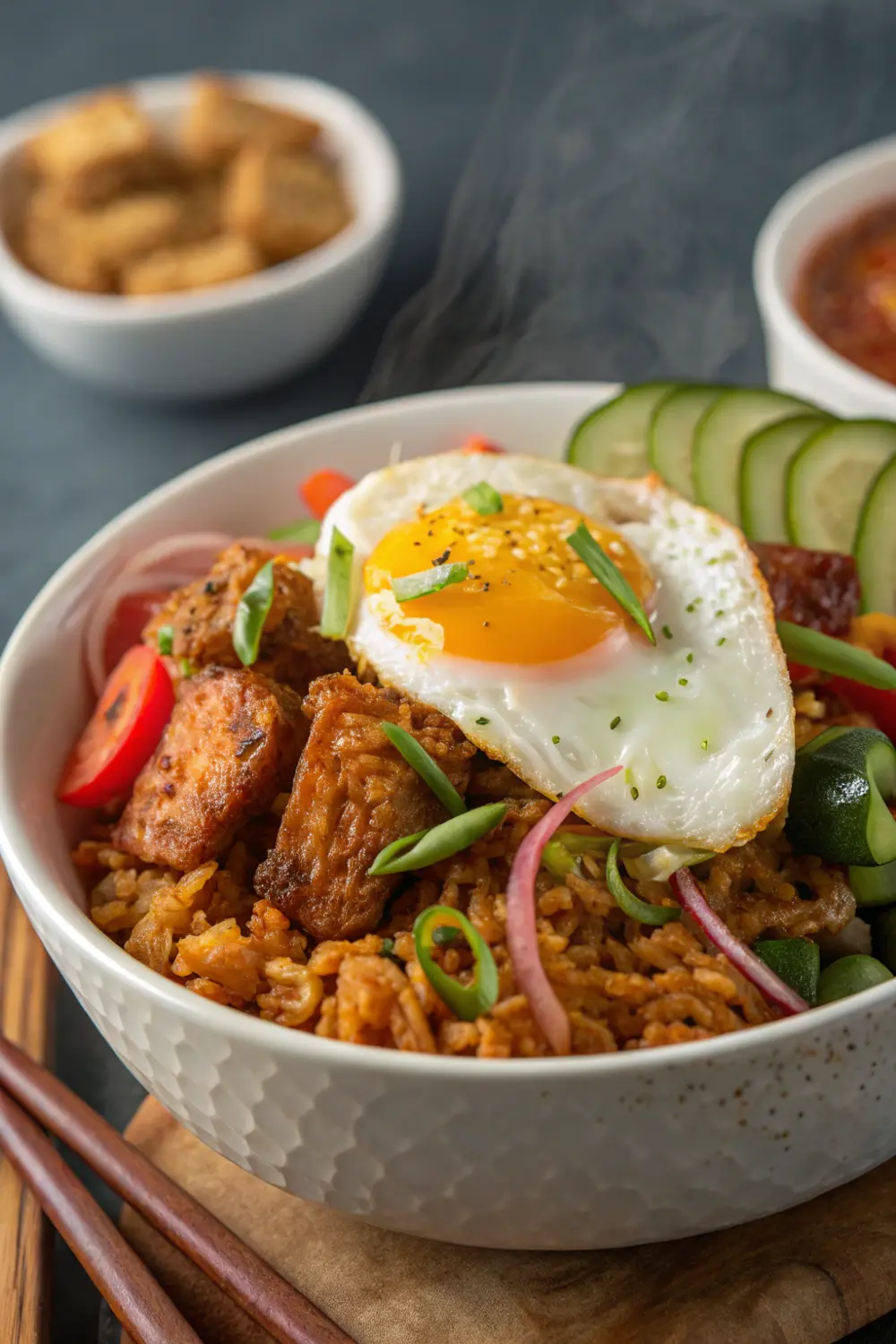
Equipment Needed to Make Indonesian Nasi Goreng
You don’t need a commercial kitchen, just a few kitchen tools to nail this Indonesian style fried rice:
- Wok or Large Skillet: Ideal for high-heat stir-frying, giving the rice that slightly smoky wok hei flavor.
- Non-stick Skillet: For frying the egg without it sticking or burning.
- Sharp Knife & Cutting Board: Essential for prepping your aromatics and veggies quickly and efficiently.
- Wooden Spoon or Spatula: For tossing the rice without breaking it apart too much.
- Mixing Bowls: For marinating tempeh or mixing sauces.
- Fine Mesh Strainer: Optional, but useful for draining pickled vegetables or rinsing tempeh before frying.
Nutritional Benefits of Nasi Goreng with Tempeh
This authentic nasi goreng isn’t just flavorful, but it’s also full of nutrition when made with the right ingredients:
1. High in Protein
- Tempeh is made from whole fermented soybeans, which means it’s not only rich in protein but also contains all nine essential amino acids, making it a complete protein, a rare find in plant-based foods.
- A fried egg on top not only adds a beautiful finishing touch but contributes an additional 6–7g of high-quality protein, along with healthy fats and a rich supply of vitamins like B12, A, D, and E.
- Including both tempeh and egg ensures your nasi goreng is nutritious and supports muscle maintenance, energy metabolism, and satiety, keeping you fuller longer.
2. Good Gut Health
Tempeh is fermented, which means it supports gut health in two ways:
- Probiotics (from the fermentation process): These beneficial bacteria help balance the microbiome, supporting better digestion, reduced bloating, and enhanced immune response.
- Prebiotic fiber: The soybeans feed your existing gut bacteria, helping create a thriving gut ecosystem.
- A healthy gut is linked to better immune health, mood regulation, and even cognitive function. If you’ve struggled with digestion or bloating, fermented foods like tempeh can make a significant difference.
3. Packed with Antioxidants
- Chilies (used in sambal or spice paste) contain capsaicin, which has powerful anti-inflammatory and antioxidant properties. It supports metabolism, may reduce pain sensitivity, and even assist with weight regulation.
- Both shallots and garlic are rich in organosulfur compounds, known for supporting immune function, helping the body detoxify, and reducing oxidative stress, which is linked to aging and chronic disease.
- Antioxidants neutralize harmful free radicals, which means they help prevent cellular damage, reduce inflammation, and protect your skin and organs from the wear and tear of daily life.
4. Rich in Vitamins
- Common vegetables used in acar, such as carrots, cucumbers, shallots, and chili, are rich in vitamin A (as beta-carotene), vitamin K, and vitamin C, which support vision, boost the immune system, and aid in skin repair.
- Adding eggs is a great way to boost your intake of vitamin B12 and vitamin D, nutrients that are essential for brain function and nerve health.
- Scallions (green onions) provide vitamin C and folate, along with flavor without calories.
5. Low in Added Sugars (If Homemade)
Many store-bought versions of kecap manis (sweet soy sauce) and sambal can contain high amounts of sugar and preservatives.
But when you make your versions at home, you control the ingredients.
Keeping added sugar low helps prevent blood sugar spikes, supports heart health, and aligns better with diabetic-friendly diets and anti-inflammatory eating.
- Use low-glycemic sweeteners like coconut sugar or date syrup in moderation.
- Balance sweetness with natural acidity from lime juice or vinegar.
- Make sambal from fresh chilies, garlic, shallots, and tomatoes, avoiding sugar-laden pre-made versions.
6. Mental Health & Mood Support
Did you know that many of the ingredients in nasi goreng can support your mental well-being?
- Eggs are rich in choline, essential for neurotransmitter function.
- Tempeh contains B vitamins and tryptophan, which help regulate mood.
- Fermented foods are being studied for their links to reduced anxiety and depression due to their impact on the gut-brain axis.
What to Serve with Nasi Goreng
To elevate your nasi goreng fried rice meal into a full Indonesian feast, consider these classic pairings:
- Acar (Pickled Vegetables): Tangy and crunchy, they balance the richness of the fried rice beautifully.
- Ayam Goreng (Indonesian Fried Chicken): Crispy fried chicken marinated in turmeric and spices, often served alongside nasi goreng.
- Telur Dadar or Telur Ceplok: For protein lovers, top each plate with a fried egg or serve thinly sliced Indonesian-style omelet strips.
- Krupuk (Prawn Crackers or Tempeh Chips): Classic Indonesian side; adds a fun crunchy element.
- Ikan Asin (Fried Salted Fish): Crispy little salted fish or anchovies for a punchy, salty-savoriness, very typical in Indonesian foods.
- Perkedel (Potato Fritters): Crispy mashed potato patties mixed with herbs and spices, comforting and popular as a side.
- Sayur Asem (Tamarind Vegetable Soup): A tangy, lightly sour vegetable soup that balances the fried rice with freshness and lightness.
- Iced Teh Botol (Sweet Jasmine Tea) or Coconut Water: Something cool and refreshing to cut the heat and cleanse the palate.
Quick Tips for Making the Best Nasi Goreng
- Use Day-Old Rice: Always use chilled, leftover rice if possible; it’s drier and yields fluffier, non-mushy fried rice. If you only have fresh rice, spread it on a tray and let it cool completely (even refrigerate briefly) to remove moisture.
- High Heat: Fry the rice on very high heat and work quickly. This helps caramelize the seasonings and gives that slightly smoky wok hei flavor.
- Stir, Don’t Mash: When tossing the rice, lift and flip it in the wok rather than smashing it down. This aerates the grains and prevents clumping.
- Customize the Heat: Adjust sambal oelek or chopped chilies to your liking. Some recipes call for Indonesian sambal or ground chili paste (such as sambal terasi) for authentic spice.
- Make It Authentic: For classic depth, stir in ½ to 1 teaspoon of shrimp paste (terasi) or a bit of fish sauce with the liquids, if you aren’t strictly vegetarian. It adds umami that deepens the dish’s savoriness.
- Tempeh Texture: Cutting tempeh into bite-size cubes and pan-frying until crisp gives a hearty, meaty texture. Alternatively, marinate tempeh first (as above) for extra flavor.
- Quick Pickles (Acar): To make simple pickled cucumbers and carrots, mix equal parts rice vinegar and water with a pinch of sugar and salt. Pour over sliced veggies and let sit at least 10 minutes (or refrigerate longer) for a bright, cooling side.
- Leftovers: You can refrigerate leftover nasi goreng for 2–3 days. Reheat on the stovetop in a hot pan (add a splash of water or oil) or microwave until steaming.
This Indonesian style fried rice is inspired by classic Indonesian cooking traditions.
Enjoy making this authentic nasi goreng recipe at home with ease!
Spicy Indonesian Nasi Goreng with Tempeh
This spicy Indonesian nasi goreng recipe is a delicious fried rice dish loaded with bold flavors, topped with a crispy fried egg and tangy pickled vegetables.
Ingredients
Cooking Instructions
Prepare the Tempeh
- In a bowl, toss the tempeh cubes with 1 tablespoon kecap manis, 1 tablespoon soy sauce, and 2 tablespoons sambal.
- Let marinate for 10–15 minutes. This infuses the tempeh with sweet-spicy flavors.
- Heat a tablespoon of vegetable oil in a wok or large skillet over medium-high heat.
- Add the tempeh and pan-fry until golden brown and slightly crisp on all sides, about 5–7 minutes.
- Remove the tempeh to a plate and set aside.
Prepare the Pickled Vegetables (Acar)
- In a small bowl, mix equal parts rice vinegar and water with a pinch of sugar and salt.
- Add the sliced cucumbers, carrots, or green beans and let sit for at least 10 minutes (or refrigerate longer) while you prepare the rest of the dish.
- Drain before using in the stir-fry.
Cook the Aromatics
- Wipe the wok clean and add 1 tablespoon of vegetable oil.
- Add the sliced shallots (or onion), minced garlic, and sliced chilies.
- Stir-fry for 1–2 minutes until fragrant and the shallots soften.
- Be careful not to burn the garlic.
Add the Pickled Vegetables (Acar)
- Add the drained pickled carrots, cucumbers, or green beans to the wok.
- Stir-fry for another 2 minutes until the vegetables just start to tenderize.
- Season with a pinch of salt and a dash of white pepper.
Cook the Nasi Goreng
- Heat the remaining 1 tablespoon of vegetable oil in a large wok and increase the heat to high until shimmering.
- If using day-old rice, transfer rice to a bowl and break rice up with your hands into individual grains, then add the rice to the wok in batches.
- Drizzle the remaining 2 tablespoons of kecap manis and 1 tablespoon of soy sauce evenly over the rice.
- The kecap manis will give the rice a rich brown-red color and sweet-salty kick.
- Add the remaining 1 tablespoon of sambal (or more to taste) for an extra kick of heat.
- Using a spatula, toss the rice thoroughly, spreading it out evenly in the wok.
- Continue stirring on high heat for 3 to 4 minutes to let a bit of char form on some grains (this wok hei or smoky char is key to authentic flavor).
Combine with Tempeh
- Return the fried tempeh to the wok.
- Toss everything together, breaking up any remaining rice clumps.
- Stir for another minute so the tempeh is heated through and coated in sauce.
- Taste the rice and season with extra soy sauce or salt if needed.
- Remove from heat.
Fry the Eggs
- In a separate nonstick skillet over medium-high heat, add a bit of oil.
- Crack an egg and fry until the edges are crispy and the yolk remains runny (for sunny-side up, cover briefly to cook the whites).
- Season the egg with salt and pepper.
- Repeat for all eggs.
Serve
- Divide the hot fried rice among serving bowls or plates.
- Plate the spicy nasi goreng, top with a fried egg, and a side of pickled vegetables.
- Sprinkle fried shallots, cilantro, and a squeeze of lime for freshness.
- The tangy pickles and cool veggies complement the spicy rice beautifully.
- Enjoy immediately while hot.
Nutrition Facts
Servings 4
Serving Size 1 bowl
- Amount Per Serving
- Calories 550kcal
- % Daily Value *
- Total Fat 18.1g28%
- Saturated Fat 4g20%
- Cholesterol 186mg62%
- Sodium 954mg40%
- Potassium 495mg15%
- Total Carbohydrate 76.7g26%
- Dietary Fiber 4.8g20%
- Sugars 10.8g
- Protein 24g48%
- Vitamin A 8635 IU
- Vitamin C 21.3 mg
- Calcium 156 mg
- Iron 4.9 mg
- Vitamin D 18.6 IU
- Vitamin K 44.8 mcg
* Percent Daily Values are based on a 2,000 calorie diet. Your daily value may be higher or lower depending on your calorie needs.
Note
- Ensure your wok or pan is very hot before adding rice. High heat is key to avoiding sogginess.
- Prep everything before you start: once the stir-frying begins, you’ll move quickly. Have all ingredients chopped and sauces measured.
- Taste as you go. Adjust seasoning (salt, pepper, chili) to make the flavor exactly how you like it.
- Don’t be afraid to customize: leftover vegetables, cooked shrimp, or a squeeze of lime on top all work. The technique remains the same.
- Watch the garlic carefully; once it browns, it can turn bitter, so remove the wok from the heat momentarily if needed.
- Fry the eggs last, they should be served hot and runny.

